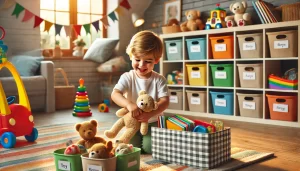Gratitude and generosity are essential values that help children develop kindness, empathy, and appreciation for what they have. When children learn to express gratitude and share with others, they build stronger relationships and develop a positive mindset that lasts a lifetime.
Teaching these values doesn’t have to be complicated—it can be incorporated into everyday moments, through play, storytelling, and real-life examples. In this article, we’ll explore why gratitude and generosity matter, practical ways to nurture them at home, and fun activities to reinforce these values.
Why Is It Important to Teach Gratitude and Generosity?
Children who learn to be grateful and generous:
- Develop empathy and kindness by recognizing the needs of others.
- Feel more satisfied and happy as they focus on what they have rather than what they lack.
- Build stronger relationships through appreciation and giving.
- Learn to handle disappointment by focusing on the positives in life.
- Grow into responsible and compassionate adults who value community and giving back.
Teaching these values early on helps shape children into thoughtful and appreciative individuals.
How to Teach Gratitude to Children
Be a Role Model of Gratitude
Children learn from watching adults. Express gratitude openly by:
- Saying “thank you” often and sincerely.
- Showing appreciation for small things (“I love how you helped me set the table today!”).
- Writing thank-you notes for gifts or kind gestures.
When children see gratitude in action, they naturally adopt it themselves.
Make Gratitude a Daily Practice
Encourage your child to reflect on what they’re thankful for each day. Some ideas include:
- Gratitude Jar – Have your child write or draw one thing they’re grateful for each day and place it in a jar. Read them together at the end of the week or month.
- Bedtime Gratitude Ritual – Before bed, ask, “What was the best part of your day?” or “What’s one thing you’re thankful for today?”
- Mealtime Gratitude Sharing – Have each family member share one thing they appreciate before eating.
These small habits make gratitude a natural part of daily life.
Encourage Saying “Thank You” Often
Teach children to say thank you not just when receiving gifts but also in everyday situations:
- Thanking teachers, friends, and family members.
- Appreciating kind gestures, like when someone holds the door open.
- Thanking nature by caring for plants and animals.
Making gratitude a habit helps children recognize and appreciate the kindness around them.
Read Books About Gratitude
Stories can help children understand the power of gratitude in a relatable way. Some great books include:
- The Thankful Book by Todd Parr (a colorful introduction to gratitude).
- Bear Says Thanks by Karma Wilson (teaches appreciation through storytelling).
- Those Shoes by Maribeth Boelts (teaches about gratitude and generosity).
After reading, discuss the story:
- “How did the character show gratitude?”
- “What are some things you feel grateful for today?”
Shift Focus from “I Want” to “I Have”
Children naturally ask for things they want, but you can help them focus on what they already have. Instead of saying, “I wish I had that toy,” encourage them to say, “I’m happy I have my favorite toy at home.”
This shift in perspective helps them appreciate what they have rather than always wanting more.
How to Teach Generosity to Children
Create Opportunities for Giving
Children feel joy in giving when they see the impact of their kindness. Encourage generosity by:
- Donating toys and clothes – Ask your child to choose items they no longer use to give to children in need.
- Making handmade gifts – Help them create cards or drawings for family members, teachers, or friends.
- Participating in charity events – Volunteer as a family at food drives, shelters, or community events.
These experiences help children understand that giving makes a difference.
Encourage Acts of Kindness
Small, everyday acts of generosity can make a big impact. Some ideas include:
- Sharing a snack with a friend.
- Helping a younger sibling with a task.
- Holding the door open for someone.
- Complimenting a friend to brighten their day.
Recognizing and praising these acts reinforces the importance of kindness.
Teach the Joy of Giving, Not Just Receiving
Many children associate celebrations with receiving gifts, but you can shift the focus to giving.
- On birthdays, encourage them to pick a small gift for a sibling or friend.
- During the holidays, have them help choose gifts for family members.
- When visiting a friend, bring a small homemade treat or drawing.
This helps children see that giving can be just as exciting as receiving.
Encourage Sharing in Playtime
Play is a great opportunity to practice generosity.
- Remind children to take turns with toys.
- Praise sharing behavior (“That was so kind of you to share your blocks!”).
- Use cooperative games where teamwork is needed instead of competition.
Teaching generosity in play helps children develop natural giving habits.
Practice “Thinking of Others”
Help children consider others’ feelings by asking:
- “How do you think your friend felt when you shared with them?”
- “What can we do to make Grandma smile today?”
- “How would you feel if someone did something nice for you?”
These questions encourage empathy and thoughtful actions.
Fun Activities to Reinforce Gratitude and Generosity
“Secret Kindness Mission”
Give your child a “kindness mission” each day, like:
- Helping a friend or sibling.
- Saying something nice to a classmate.
- Drawing a picture for a family member.
Make it fun by keeping it a secret mission until the act is completed!
The “Giving Tree” Activity
Create a paper tree and add “leaves” with different acts of generosity written on them. Each time your child does something kind, they add a leaf. Watching the tree grow shows how small acts of kindness add up.
Start a “Kindness Chain”
For every kind act, add a paper link to a kindness chain. See how long the chain can get by the end of the month!
Play “Gratitude Scavenger Hunt”
Challenge your child to find:
- Something they love in their home.
- Someone they’re grateful for.
- A food they enjoy eating.
- A toy they appreciate.
This game helps children recognize the good things around them.
Write “Thank-You” Notes Together
Have your child create thank-you notes for teachers, family members, or friends. Writing out their gratitude makes them more mindful of appreciation.
When to Seek Additional Support
If a child struggles with gratitude and generosity despite guidance, it may be helpful to:
- Provide more hands-on giving experiences.
- Reinforce positive behaviors with encouragement.
- Talk about feelings and why gratitude matters.
In rare cases, consistent selfish behaviors may indicate a deeper challenge, and professional guidance may help.
Final Thoughts
Teaching gratitude and generosity helps children develop empathy, kindness, and a positive outlook on life. By incorporating small daily practices, encouraging giving, and leading by example, parents can instill these values in a natural and meaningful way.
With patience and consistent reinforcement, gratitude and generosity will become second nature to your child, helping them grow into a thoughtful and compassionate individual.




